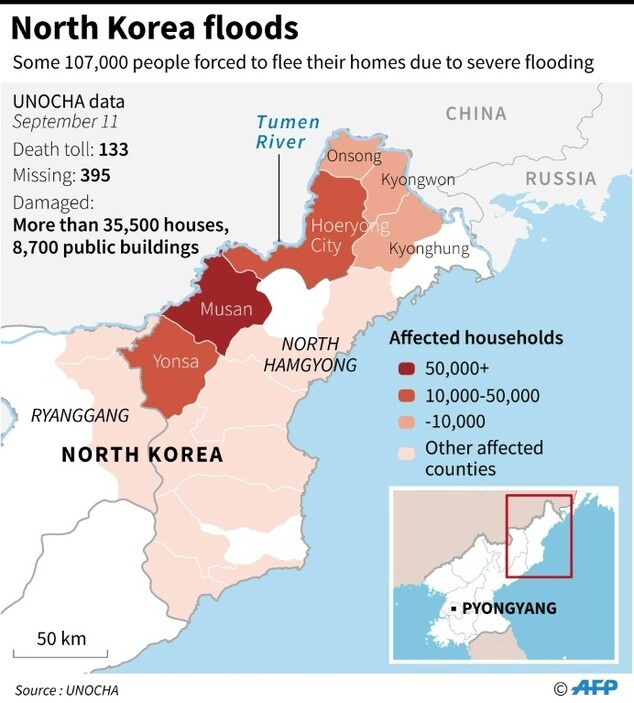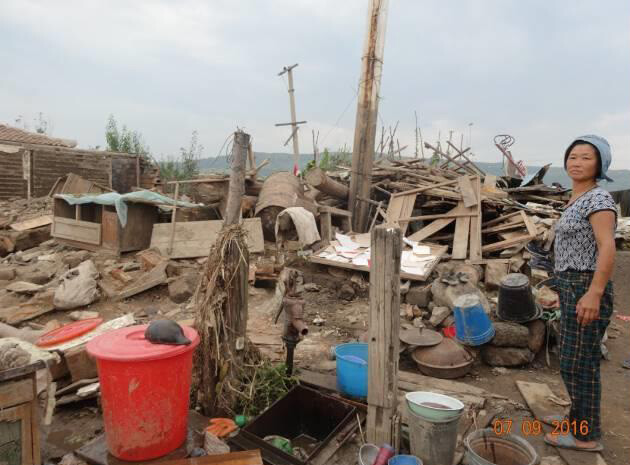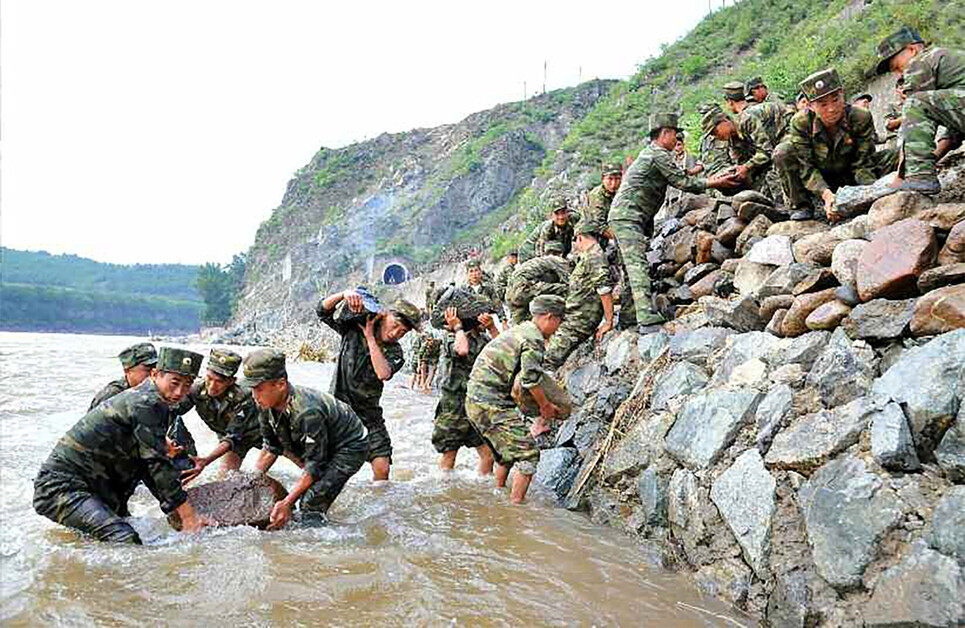hankyoreh
Links to other country sites 다른 나라 사이트 링크
Devastating floods in North Korea could spur change from int’l sanctions

While the international community had seemed bent on toughening sanctions against North Korea after its fifth nuclear test, there are indications that this mood is shifting following reports about severe flooding in the northern part of North Korea’s North Hamgyong Province. Thirteen UN-affiliated humanitarian organizations operating in North Korea have published a jointly drafted report about the situation on the ground and are appealing to the international community for emergency aid.
South Korean groups dedicated to providing humanitarian aid to North Korea have also launched a campaign to raise money to provide relief to the victims of the flooding and have asked for permission to contact North Korea to get a better picture of what is happening there. Thus far, the South Korean government has made no response, citing a lack of an official request for aid from North Korea. It remains to be seen whether these developments will cause Seoul to change its stance.
The flooding - which the North Korean government has described as “the worst catastrophe according to meteorological observation since liberation” - was caused by torrential rain in the northern part of North Hamgyong Province from Aug. 29 to Aug. 31. The rains were produced by the convergence of Typhoon Lionrock, this year‘s tenth typhoon in the Pacific Ocean, and a low pressure front in the region.
A four-hour downpour on the night of Aug. 30 and the early morning of Aug. 31 raised the level of the Tumen River to 6 to 12 meters higher than normal, and the resulting floods have caused extensive damage.
According to the joint report about damage from the flooding in North Hamgyong Province that was released by the UN humanitarian aid organizations on Sep. 16, the damage has been concentrated in the city of Hoeryong and six surrounding areas, including Onsong, Musan, and Yonsa counties. There are more than 667,000 people living in these administrative districts.
The report was prepared by a team of 22 people who surveyed the affected areas from Sep. 6 to Sep. 9. The team was made up of North Korean government officials and a delegation from 13 UN humanitarian organizations with permanent operations in North Korea, including the World Food Programme (WFP) and the World Health Organization (WHO).
According to the report, more than 500 casualties have already been confirmed, including 138 dead and 398 missing. More than 37,000 houses have been flooded, including more than 15,740 that have been completely destroyed, affecting more than 118,000 people.

When the Tumen River overwhelmed an earthen embankment, it swept away every single building in the Gangan neighborhood of Hoeryong, located immediately behind the embankment, the fact-finding team reported. Before the flood, 4,524 people in 1,177 households were living in the neighborhood.
Since fields of crops were inundated just before the harvest, the team concluded that it will be impossible to bring in the rice, corn and other crops grown in the area. “According to Government figures, 78 per cent of the population of North Hamgyong Province was dependent on the Public Distribution System (PDS) before the flood event,” the report said.
With sections of roads and bridges submerged and destroyed because of the flooding and landslides, the parts of Musan and Yonsa countries that were hardest hit by the flooding are still inaccessible.
The report said that in affected areas, “Anecdotal reports are that overnight temperatures of -3˚ are common in October,” and “there are significant risks of widespread outbreaks of communicable diseases especially of diarrhea and acute respiratory illnesses.”
The WFP and other UN agencies are gearing up to send relief supplies on hand to the affected area in order to assist the most vulnerable, including children, mothers recovering from childbirth, the elderly and the infirm. On Sep. 14, the WHO also decided that it would make an emergency investment of US$175,000 to provide medical assistance. The UN believes that more than 140,000 people are in need of emergency assistance.
Although the North Korean government dallied in drawing attention to the devastation, it is also working to provide aid and relief to the affected areas. Even people working on construction sites on Ryomyong Street in Pyongyang, a pet project of North Korean leader Kim Jong-un, have already been urgently dispatched to the flooded areas.
On Sep. 14, North Korea’s Foreign Ministry held a briefing for diplomats from nine Asian countries (including Mongolia and Vietnam) who are based in Pyongyang and asked them to help the North rebuild after the flood.

A fundraising campaign for North Korea has already begun in South Korea’s private sector as well. The Korea NGO Council for Cooperation with North Korea, which represents 54 humanitarian aid groups, held an emergency meeting on Sep. 5, and its standing committee met on Sep. 9. During the meetings, the council resolved to raise 200 million won (US$178,000) to provide aid for the North Korean flooding.
“Immediately after our emergency meeting on Sep. 5, we submitted a request to the Unification Ministry to make contact with the North Korean Council for Reconciliation and Cooperation in order to confirm the extent of the damage, but we have yet to receive a response. It’s really frustrating, since we have to make contact with them to determine how bad things are and what supplies are needed,” said Gwak Yeong-ju, head of the operating committee of the Korea NGO Council for Cooperation with North Korea on Sep. 18.
The Enforcement Decree of the Inter-Korea Exchange and Cooperation Act states that the South Korean government must decide whether to grant a request to make contact with North Korea and to provide notification of its decision within seven days of receiving the request. Since North Korea‘s fourth nuclear test, on Jan. 6, the administration of South Korean President Park Geun-hye has placed a de facto ban on contact with North Korea.
“We will continue to review the possibility of providing assistance for the flooding, including emergency humanitarian aid, in consideration of all factors, such as whether the North Korean government has officially requested it, as well as the extent of the damage, urgency and necessity,” said Ministry of Unification spokesman Jeong Joon-hee on Sep. 18, once again reiterating Seoul’s standard position.
“Recently, the North Korean leadership has been regarded with caution and hostility because of its development of nuclear weapons, but apart from this, humanitarian principles demand that we work with international organizations to provide swift relief aid,” said Kim Jong-in, former leader of the opposition Minjoo Party’s emergency committee, in a post on his Facebook page.
People’s Party Emergency Committee Chairman Park Jie-won also addressed the issue on his Facebook page. “If we give [North Korea] any of our surplus rice for humanitarian reasons, they‘ll say that we’re helping the North pay for its nuclear weapon and missile programs. But we believe that it‘s time for a change of thinking,” Park said.
By Jung In-hwan and Lee Se-young, staff reporters
Please direct questions or comments to [english@hani.co.kr]

Editorial・opinion
![[Column] Season 2 of special prosecutor probe may be coming to Korea soon [Column] Season 2 of special prosecutor probe may be coming to Korea soon](https://flexible.img.hani.co.kr/flexible/normal/500/300/imgdb/original/2024/0426/3317141030699447.jpg) [Column] Season 2 of special prosecutor probe may be coming to Korea soon
[Column] Season 2 of special prosecutor probe may be coming to Korea soon![[Column] Park Geun-hye déjà vu in Yoon Suk-yeol [Column] Park Geun-hye déjà vu in Yoon Suk-yeol](https://flexible.img.hani.co.kr/flexible/normal/500/300/imgdb/original/2024/0424/651713945113788.jpg) [Column] Park Geun-hye déjà vu in Yoon Suk-yeol
[Column] Park Geun-hye déjà vu in Yoon Suk-yeol- [Editorial] New weight of N. Korea’s nuclear threats makes dialogue all the more urgent
- [Guest essay] The real reason Korea’s new right wants to dub Rhee a founding father
- [Column] ‘Choson’: Is it time we start referring to N. Korea in its own terms?
- [Editorial] Japan’s rewriting of history with Korea has gone too far
- [Column] The president’s questionable capacity for dialogue
- [Column] Are chaebol firms just pizza pies for families to divvy up as they please?
- [Column] Has Korea, too, crossed the Rubicon on China?
- [Correspondent’s column] In Japan’s alliance with US, echoes of its past alliances with UK
Most viewed articles
- 1No good, very bad game for Korea puts it out of Olympics for first time since 1988
- 2Division commander ordered troops to enter raging flood waters before Marine died, survivor says
- 3Korea’s 1.3% growth in Q1 signals ‘textbook’ return to growth, says government
- 4Will NewJeans end up collateral damage in internal feud at K-pop juggernaut Hybe?
- 5[Column] Season 2 of special prosecutor probe may be coming to Korea soon
- 6[Editorial] Korea’s surprise Q1 growth requires objective assessment, not blind fanfare
- 7[Column] ‘Choson’: Is it time we start referring to N. Korea in its own terms?
- 8‘We must say no’: Seoul defense chief on Korean, USFK involvement in hypothetical Taiwan crisis
- 9Korea sees more deaths than births for 52nd consecutive month in February
- 10Is N. Korea threatening to test nukes in response to possible new US-led sanctions body?